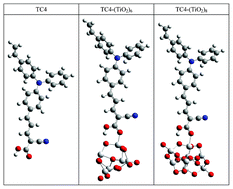TDDFT studies of electronic spectra and excited states of the triphenylamine-based organic sensitizers and organic sensitizer–titanium dioxide cluster complexes†
Abstract
The

* Corresponding authors
a
School of Physics and Optoelectronic Technology, and College of Advanced Science and Technology, Dalian University of Technology, Dalian, 116024, P. R. China
E-mail:
mdchen@dlut.edu.cn
b College of Science, Northeast Forestry University, Harbin, 150040, P. R. China
The

 Please wait while we load your content...
Something went wrong. Try again?
Please wait while we load your content...
Something went wrong. Try again?
H. Li, Y. Li and M. Chen, RSC Adv., 2013, 3, 12133 DOI: 10.1039/C3RA41816B
To request permission to reproduce material from this article, please go to the Copyright Clearance Center request page.
If you are an author contributing to an RSC publication, you do not need to request permission provided correct acknowledgement is given.
If you are the author of this article, you do not need to request permission to reproduce figures and diagrams provided correct acknowledgement is given. If you want to reproduce the whole article in a third-party publication (excluding your thesis/dissertation for which permission is not required) please go to the Copyright Clearance Center request page.
Read more about how to correctly acknowledge RSC content.
 Fetching data from CrossRef.
Fetching data from CrossRef.
This may take some time to load.
Loading related content
